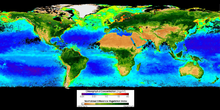Economy

Food systems have complex economic and social value chains that effect many parts of the global economy.
Production
Most food has always been obtained through agriculture. With increasing concern over both the methods and products of modern industrial agriculture, there has been a growing trend toward sustainable agricultural practices. This approach, partly fueled by consumer demand, encourages biodiversity, local self-reliance and organic farming methods. Major influences on food production include international organizations (e.g. the World Trade Organization and Common Agricultural Policy), national government policy (or law), and war.
Several organisations have begun calling for a new kind of agriculture in which agroecosystems provide food but also support vital ecosystem services so that soil fertility and biodiversity are maintained rather than compromised. According to the International Water Management Institute and UNEP, well-managed agroecosystems not only provide food, fiber and animal products, they also provide services such as flood mitigation, groundwater recharge, erosion control and habitats for plants, birds, fish and other animals.
Food manufacturing
Packaged foods are manufactured outside the home for purchase. This can be as simple as a butcher preparing meat, or as complex as a modern international food industry. Early food processing techniques were limited by available food preservation, packaging, and transportation. This mainly involved salting, curing, curdling, drying, pickling, fermenting, and smoking. Food manufacturing arose during the industrial revolution in the 19th century. This development took advantage of new mass markets and emerging technology, such as milling, preservation, packaging and labeling, and transportation. It brought the advantages of pre-prepared time-saving food to the bulk of ordinary people who did not employ domestic servants.
At the start of the 21st century, a two-tier structure has arisen, with a few international food processing giants controlling a wide range of well-known food brands. There also exists a wide array of small local or national food processing companies. Advanced technologies have also come to change food manufacture. Computer-based control systems, sophisticated processing and packaging methods, and logistics and distribution advances can enhance product quality, improve food safety, and reduce costs.
International food imports and exports
The World Bank reported that the European Union was the top food importer in 2005, followed at a distance by the US and Japan. Britain's need for food was especially well-illustrated in World War II. Despite the implementation of food rationing, Britain remained dependent on food imports and the result was a long term engagement in the Battle of the Atlantic.
Food is traded and marketed on a global basis. The variety and availability of food is no longer restricted by the diversity of locally grown food or the limitations of the local growing season. Between 1961 and 1999, there was a 400% increase in worldwide food exports. Some countries are now economically dependent on food exports, which in some cases account for over 80% of all exports.
In 1994, over 100 countries became signatories to the Uruguay Round of the General Agreement on Tariffs and Trade in a dramatic increase in trade liberalization. This included an agreement to reduce subsidies paid to farmers, underpinned by the WTO enforcement of agricultural subsidy, tariffs, import quotas, and settlement of trade disputes that cannot be bilaterally resolved. Where trade barriers are raised on the disputed grounds of public health and safety, the WTO refer the dispute to the Codex Alimentarius Commission, which was founded in 1962 by the United Nations Food and Agriculture Organization and the World Health Organization. Trade liberalization has greatly affected world food trade.
Marketing and retailing
Food marketing brings together the producer and the consumer. The marketing of even a single food product can be a complicated process involving many producers and companies. For example, fifty-six companies are involved in making one can of chicken noodle soup. These businesses include not only chicken and vegetable processors but also the companies that transport the ingredients and those who print labels and manufacture cans. The food marketing system is the largest direct and indirect non-government employer in the United States.
In the pre-modern era, the sale of surplus food took place once a week when farmers took their wares on market day into the local village marketplace. Here food was sold to grocers for sale in their local shops for purchase by local consumers. With the onset of industrialization and the development of the food processing industry, a wider range of food could be sold and distributed in distant locations. Typically early grocery shops would be counter-based shops, in which purchasers told the shop-keeper what they wanted, so that the shop-keeper could get it for them.
In the 20th century, supermarkets were born. Supermarkets brought with them a self service approach to shopping using shopping carts, and were able to offer quality food at lower cost through economies of scale and reduced staffing costs. In the latter part of the 20th century, this has been further revolutionized by the development of vast warehouse-sized, out-of-town supermarkets, selling a wide range of food from around the world.
Unlike food processors, food retailing is a two-tier market in which a small number of very large companies control a large proportion of supermarkets. The supermarket giants wield great purchasing power over farmers and processors, and strong influence over consumers. Nevertheless, less than 10% of consumer spending on food goes to farmers, with larger percentages going to advertising, transportation, and intermediate corporations.
Comments
Post a Comment